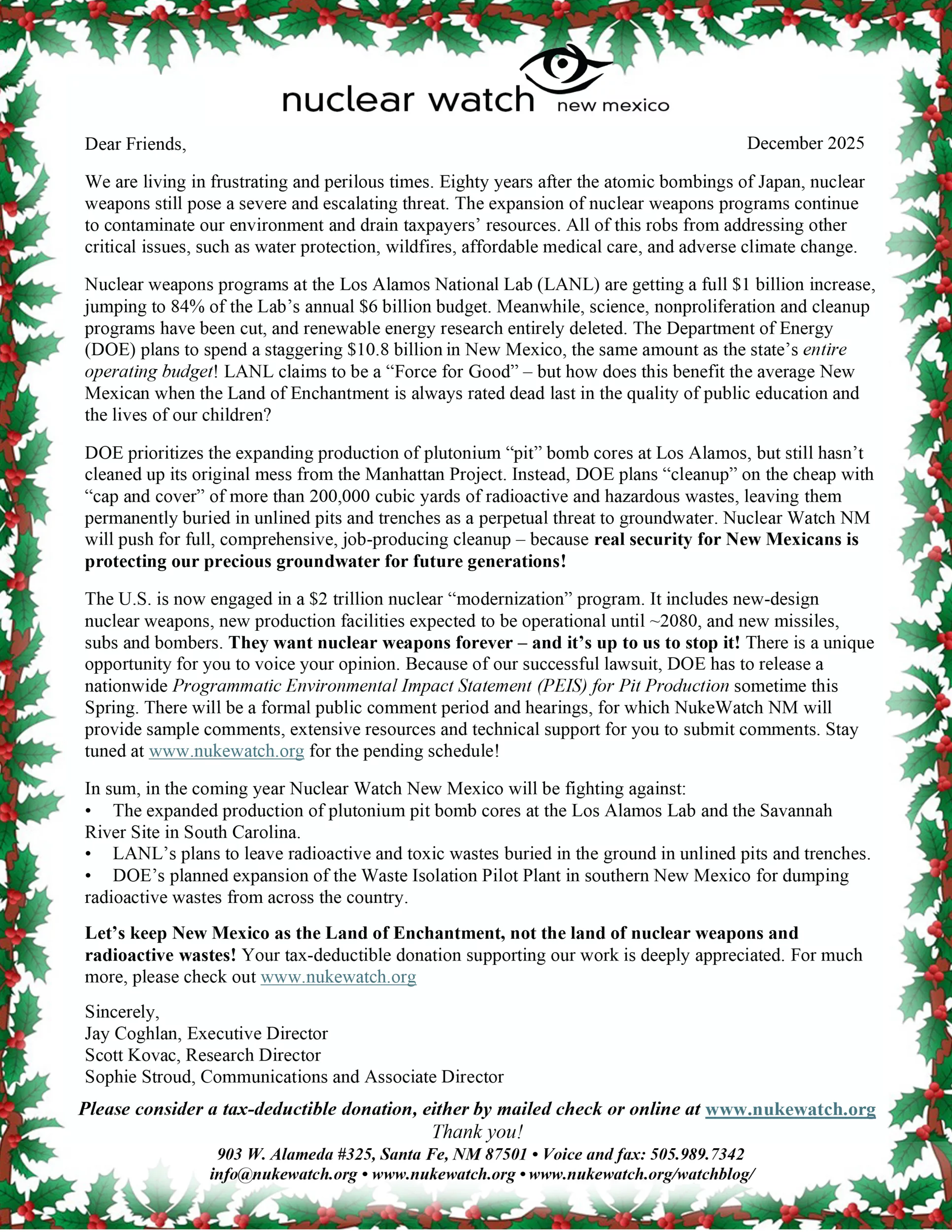QUOTE OF THE WEEK
Nothing Found
It seems we can’t find what you’re looking for. Perhaps searching can help.
LANL’s Central Mission: Los Alamos Lab officials have recently claimed that LANL has moved away from primarily nuclear weapons to “national security”, but what truly remains as the Labs central mission? Here’s the answer from one of its own documents:
LANL’s “Central Mission”- Presented at: RPI Nuclear Data 2011 Symposium for Criticality Safety and Reactor Applications (PDF) 4/27/11
Banner displaying “Nuclear Weapons Are Now Illegal” at the entrance in front of the Los Alamos National Lab to celebrate the Entry Into Force of the Nuclear Weapon Ban Treaty on January 22, 2021
Nothing Found
It seems we can’t find what you’re looking for. Perhaps searching can help.
Follow the Money!
Livermore FY26 Budget Request (Courtesy of Tri-Valley CAREs)
Map of “Nuclear New Mexico”
In 1985, US President Ronald Reagan and Russian President Mikhail Gorbachev declared that “a nuclear war cannot be won and must never be fought.”

NEW & UPDATED
Independent Government Accountability Office Releases Scathing Report on Expanding Plutonium Pit Production; Pressure Mounts on Los Alamos Lab to Increase Production
Santa Fe, NM – Today, the independent Government Accountability Office (GAO) released a scathing report entitled NNSA Does Not Have a Comprehensive Schedule or Cost Estimate for Pit Production Capability. The National Nuclear Security Administration (NNSA) and its parent Department of Energy have been on the GAO’s High Risk List for project mismanagement since 1991.
Plutonium pits are the essential radioactive cores of nuclear weapons. There has been only limited production at the Los Alamos National Laboratory (LANL) since 1989 when a FBI raid investigating environmental crimes abruptly shut down production at the Rocky Flats Plant near Denver. NNSA now plans to spend $2.9 billion in FY 2023 alone to establish production of at least 30 pits per year at LANL and 50 pits per year at the Savannah River Site (SRS) in South Carolina.
The two main findings of GAO’s report are:
- NNSA’s Plutonium Pit Production Scope of Work Includes Dozens of Programs, Projects, and Other Activities Managed by Multiple NNSA Offices at Multiple Sites (p 19)
GAO: Cost, time estimates for making nuclear bomb cores flawed – Santa Fe New Mexican
The GAO report said the lack of detailed estimates of the costs, time and resources involved is especially glaring because this is the largest and most expensive weapons project undertaken by the National Nuclear Security Administration, the Energy Department branch that oversees the arsenal.
“Jay Coghlan, executive director of Nuclear Watch New Mexico, said an agency that boasts about having top-level technicians should have no problem supplying all the necessary information about pit production, including total costs.”
BY SCOTT WYLAND, THE SANTA FE NEW MEXICAN | January 13, 2023 santafenewmexian.com
Estimates for costs and the time required to produce nuclear bomb cores, including 30 per year at Los Alamos National Laboratory, are severely lacking and could make it difficult for federal managers to avoid cost overruns, delays and other problems, a government watchdog said in a report released Thursday.
The plan for the lab and the Savannah River Site in South Carolina to produce a combined 80 nuclear warhead triggers, or “pits,” each year by 2035 is a massive, complex undertaking that demands detailed scheduling, a careful accounting of costs and clear estimates of how long various tasks will take — none of which are being done by the federal agency in charge of nuclear weapons, the Government Accountability Office said in its 78-page report.
US nuclear agency falls short on scheduling, cost estimates
The U.S. agency in charge of jumpstarting the production of key components for the nation’s nuclear arsenal is falling short when it comes to having a comprehensive schedule for the multibillion-dollar project
“Jay Coghlan, executive director of Nuclear Watch New Mexico, pointed to some of the price tags associated with the project having doubled over the last four years. He said production overall at the two sites could cost at least $60 billion over 30 years with radioactive waste disposal and other environmental and public health concerns adding to the bill.
“Until Congress and the New Mexican delegation demand credible cost estimates and schedules, Coghlan said lawmakers “should stop rewarding the guilty with yet more money…That is simple good governance that could help slow our sleepwalk into the new and unpredictable nuclear arms race,” he said.
BY SUSAN MONTOYA BRYAN, THE ASSOCIATED PRESS – KOB, THE WASHINGTON POST, US NEWS, ABC NEWS | January 13, 2023
RE: The Santa Fe New Mexican “GAO: Cost, time estimates for making nuclear bomb cores flawed” – Underneath it All is the Nuclear Elephant in the Room: Future Pit Production is Actually Unnecessary.
BY JAY COGHLAN
Good article indeed. Kudos to Scott Wyland.
But to add to it:
The National Nuclear Security Administration (NNSA) cannot do, or rather will not do, good governance 101 for its largest program ever (i.e., expanded plutonium pit production), which is credible cost estimates and schedules. Why won’t NNSA do that? Because of PR and political concerns when their flaky cost estimates (such as they are) get blown up by inevitable escalating costs. NNSA knows that if it gave accurate projected costs Congress and the public would balk. Thus, the agency goes in lowballing costs, which always inevitably rise. I could rattle off a dozen NNSA projects over the last 15 years in which costs have exploded, wasting tens of billions of taxpayers’ dollars.
But get this, future pit production is also unnecessary and may actually degrade national security. To begin with, independent experts have found that pits have serviceable lifetimes of at least a century (their average age is now around 40). And we already have at least 15,000 existing pits stored at the Pantex Plant near Amarillo, TX.
The Results Are In! Staff at Ukraine’s Zaporizhzhia Nuclear Power Plant Recognized as 2022 Arms Control Persons of the Year – SANTA FE ARCHBISHOP JOHN C. WESTER RUNNER-UP! Thank you for voting!
ARMS CONTROL ASSOCIATION | January 13, 2023 armscontrol.org Media Contacts: Tony Fleming, director for communications, Daryl G. Kimball, executive director
(Washington, D.C.)—The Energoatom staff at Ukraine’s Zaporizhzhia nuclear power plant (ZNPP) were selected as the 2022 Arms Control Persons of the Year through an online poll that drew more than 3,500 participants from nearly 80 countries.
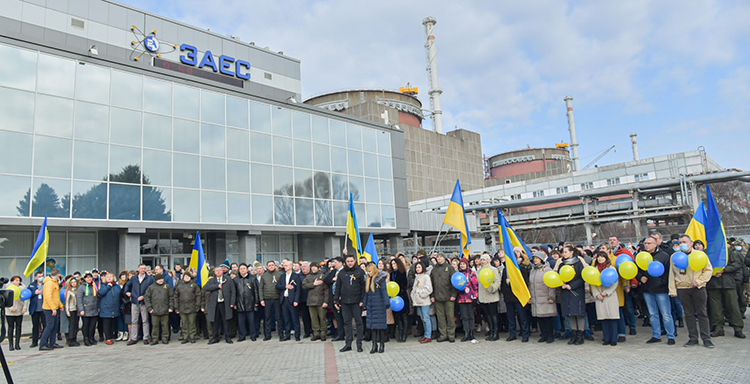
Zaporizhzhia staff gathered Feb. 16, 2022, for a day of unity celebrated by Energoatom’s employees. (Photo: Energoatom)
The annual contest is organized by the independent, nongovernmental Arms Control Association to highlight positive initiatives—some at the grassroots level, some on the international scale—designed to advance disarmament, nuclear security, nonproliferation, civilian protection, and international peace, security, and justice.
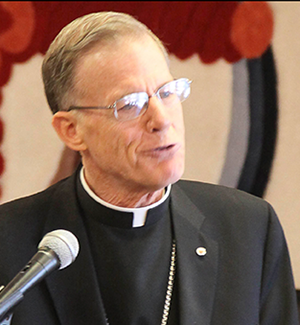 The runner-up in this year’s contest was Archbishop John Wester of Santa Fe, nominated for preaching the nuclear disarmament gospel in a religious context. His January 2022 pastoral letter reflects the Catholic Church’s long history of speaking out against the threats posed by nuclear weapons and calls on U.S. citizens to take “concrete steps toward abolishing nuclear weapons and ending the nuclear threat.”
The runner-up in this year’s contest was Archbishop John Wester of Santa Fe, nominated for preaching the nuclear disarmament gospel in a religious context. His January 2022 pastoral letter reflects the Catholic Church’s long history of speaking out against the threats posed by nuclear weapons and calls on U.S. citizens to take “concrete steps toward abolishing nuclear weapons and ending the nuclear threat.”
The December 2022 issue of Arms Control Today includes an interview with Wester by editor Carol Giacomo titled: “Making the Case That Nuclear Weapons Are Immoral.”
In a First, South Korea Declares Nuclear Weapons a Policy Option
“Mr. Yoon himself reiterated on Thursday that his country remained committed to the NPT, at least for now. He said on Wednesday — and his Defense Ministry reiterated on Thursday — that the more
“realistic means” of countering the North Korean threat would be through joint deterrence with the United States.”
BY CHOE SANG-HUN, THE NEW YORK TIMES | January 12, 2023 nytimes.com
President Yoon Suk Yeol said that if North Korea’s nuclear threat grows, his country may build a nuclear arsenal of its own or ask the United States to redeploy in the South.
LANL waste contractor receives lowest score in its tenure, receives $7.16 million bonus
“It’s the lowest score on the lowest bar of so-called cleanup,” said Jay Coghlan, executive director of Nuclear Watch New Mexico. “I’m going to very much point my finger at the weak and defective 2016 consent order.”
Coghlan is among the critics who have bashed this cleanup agreement crafted under Republican Gov. Susana Martinez, saying it weakened the original 2005 order by eliminating real deadlines and imposing few penalties for slow or deficient work.
By Scott Wyland, The Santa Fe New Mexican | January 7, 2023 santafenewmexican.com
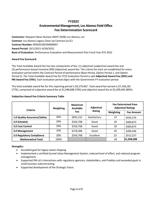 The contractor in charge of cleaning up Los Alamos National Laboratory’s legacy waste will receive the lowest percentage of its yearly bonus in its four years at the lab, mainly because of deficiencies in worker safety and packaging waste for shipping.
The contractor in charge of cleaning up Los Alamos National Laboratory’s legacy waste will receive the lowest percentage of its yearly bonus in its four years at the lab, mainly because of deficiencies in worker safety and packaging waste for shipping.
Newport News BWXT, commonly known as N3B, received 77% of its bonus fees for the year ending in October, the lowest since it began cleaning up the lab’s pre-1999 waste in 2018 and the first time the portion fell below 80%.
The U.S. Energy Department’s Environmental Management Field Office at Los Alamos issues the scorecards that determine how much of a bonus fee N3B will get in a given year under its $1.4 billion, 10-year contract for the cleanup work.
The contractor will be awarded about $7.16 million out of a possible $9.2 million, according to the 2022 scorecard.
The C-17A Has Been Cleared To Transport B61-12 Nuclear Bomb To Europe
“At this point in time, it is unknown if B61-12 shipments to Europe have begun. If not, it appears to be imminent. That said, deployment will probably not happen in one move but gradually spread to more and more bases depending on certification and construction at each base.”
By Hans Kristensen, FEDERATION OF AMERICAN SCIENTISTS | January 6, 2023 fas.org
In November 2022, the Air Force updated its safety rules for airlift of nuclear weapons to allow the C-17A Globemaster III aircraft to transport the new B61-12 nuclear bomb.
The update, accompanied by training and certification of the aircraft and crews, cleared the C-17A to transport the newest U.S. nuclear weapon to bases in the United States and Europe.
🗣️No new nuclear weapons in Europe!
The majority of people in European host countries object to nuclear weapons being stationed on their soil and want to join the #nuclearban! pic.twitter.com/jPJpq9aLqp
— ICAN (@nuclearban) January 7, 2023
Nuke waste rules proposed for Carlsbad-area site critiqued by watchdogs, local leaders
“We are opposed to the idea of continuing to expand the WIPP underground…Back when this got started, everyone agreed it would take 25 years and all the waste would be emplaced…That’s not going to happen by 2024.
That’s not the citizens of New Mexico’s fault or NMED’s fault. It’s on the DOE. They don’t want an end date. That’s something we need to push on.” — Nuclear Waste Program Director Don Hancock of the Southwest Research and Information Center
By Adrian Hedden Carlsbad Current-Argus | January 6, 2023 news.yahoo.com
The Waste Isolation Pilot Plant operates under a permit with the New Mexico Environment Department (NMED), which is renewed every 10 years.
That process is ongoing for WIPP, and NMED added several provisions in a draft permit released last month that called for a stricter accounting of waste coming to WIPP each year, required updates on the process of finding a new repository and demanded a greater priority be placed on disposal of nuclear waste generated in New Mexico.
Feds push plan to dispose plutonium using nuclear waste repository near Carlsbad
“We want an end to the situation where New Mexico is the only nuclear waste dump for all 50 states. The concern is that if you increase the number of shipments, the number of years, and you increase the dangerousness of the waste, at some point, somewhere an accident is inevitable.” – Cindy Weehler, co-chair of Santa Fe-based activist group 285 ALL
By Adrian Hedden Carlsbad Current-Argus | January 5, 2023 currentargus.com
Federal nuclear waste managers said they planned to dispose of 34 metric tons of surplus, weapons-grade plutonium at a nuclear repository in New Mexico after the waste is diluted to a lower level of radioactivity.
The National Nuclear Security Administration (NNSA) proposed in 2020 a “dilute and dispose” method of eliminating the plutonium from the environment, ultimately via emplacement at the Waste Isolation Pilot Plant repository near Carlsbad.
Before that can happen, the NNSA said the waste can be “downblended” to meet requirements at WIPP, which is designed to dispose of transuranic (TRU) waste that can only be of a certain level of radioactivity.
Albuquerque Journal Editorial: NM right to ask for accounting of nuclear waste
“I think there’s this mentality that New Mexico can just be the forever home for all the nation’s waste. It’s an exploitative mentality regarding our state.” — Sen. Jeff Steinborn, D-Las Cruces
BY ALBUQUERQUE JOURNAL EDITORIAL BOARD | January 4, 2023 abqjournal.com
It is more than fair, when you house a radioactive waste facility like the Waste Isolation Pilot Plant, to ask how much waste from the nation’s nuclear weapons program still needs a home.
Especially when the nation keeps making more.
In the proposed permit for the federal government to continue storing nuclear waste at WIPP in southeastern New Mexico, the New Mexico Environment Department is seeking a full accounting from the U.S. Energy Department of materials still needing to be cleaned up and shipped to WIPP from laboratories and defense-related sites around the country. It also suggests developing another storage site (Hint: How about the $13.5 billion already spent on Yucca Mountain?). And it puts Congress — the same Congress that just approved spending more to make key plutonium components for the nation’s nuclear arsenal, which will also make more radioactive waste — on notice that if lawmakers expand the type of waste accepted at WIPP, the permit will be revoked.
Los Alamos National Laboratory’s record $4.6B budget will still mostly fund nuclear weapons
“This year’s $858 billion military budget is the largest in memory. And the National Nuclear Security Administration, the Energy Department branch that oversees nuclear weapons, received $22.3 billion, a bump from the $20.7 billion it got last year.”
BY SCOTT WYLAND, THE SANTA FE NEW MEXICAN | January 4, 2023 stripes.com
(Tribune News Service) — Los Alamos National Laboratory’s record $4.6 billion budget for this fiscal year will give officials an unprecedented amount of money for its nuclear weapons program, which still makes up the bulk of the lab’s spending.
The lab’s hefty funding was part of the U.S. Energy Department’s budget request tucked into the recently passed $1.7 trillion omnibus spending package, which will cover the costs of agencies and programs through this fiscal year, ending in October.
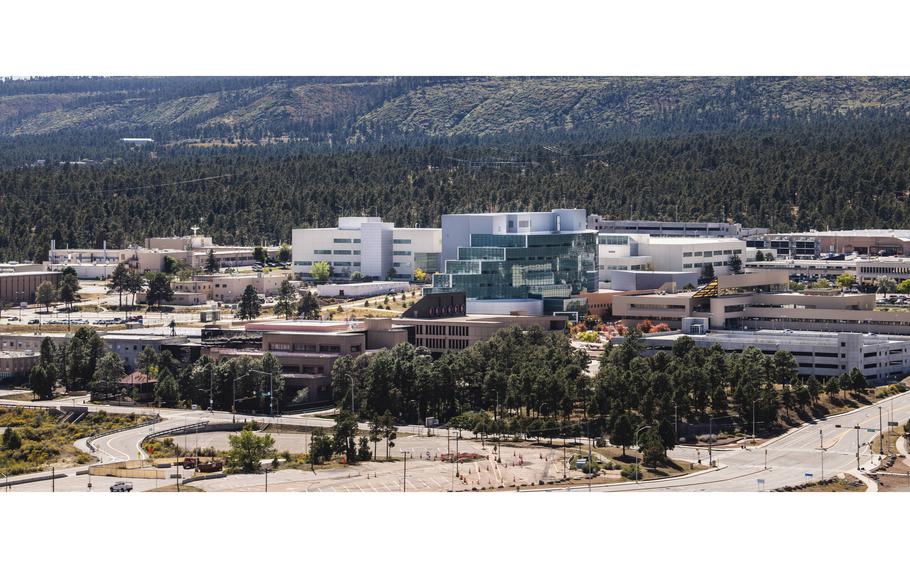
Roughly 70 percent of the lab’s funding is for its nuclear weapons program, which includes research, computer testing and pursuing the goal of producing 30 plutonium bomb cores or “pits” per year by 2026.
Nothing Found
It seems we can’t find what you’re looking for. Perhaps searching can help.
Nothing Found
It seems we can’t find what you’re looking for. Perhaps searching can help.
Waste Lands: America’s Forgotten Nuclear Legacy
The Wall St. Journal has compiled a searchable database of contaminated sites across the US. (view)
Related WSJ report: https://www.wsj.com
New Nuclear Media: Art, Films, Books & More
Nothing Found
It seems we can’t find what you’re looking for. Perhaps searching can help.
Nothing Found
It seems we can’t find what you’re looking for. Perhaps searching can help.















